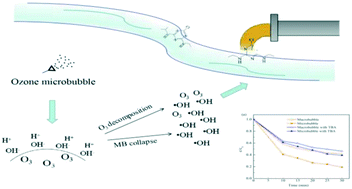Enhanced degradation of atrazine by microbubble ozonation†
Abstract
Atrazine has been widely used as a synthetic herbicide in many countries. Due to its persistence and mobility, atrazine is difficult to eliminate by conventional treatment processes or biodegradation and may cause varying degrees of harm to untargeted organisms and threaten environmental sustainability. In recent years, microbubble ozonation has been reported to accelerate the removal of persistent organic pollutants, but there has been little research on the removal of atrazine using this approach. In this study, microbubble ozonation was shown to enhance the degradation of atrazine under a variety of pH conditions compared to macrobubble ozonation using the same concentration of aqueous ozone. The microbubble surface is usually negatively charged and hydroxyl ions accumulating at the gas–liquid interface can promote the self-decomposition of ozone and the formation of hydroxyl radicals. This promotion of ozone decomposition by microbubbles, together with the effect of microbubble collapse, were the major reasons for the enhanced degradation of atrazine. Common background components in water include organic humic acids, metal ions and inorganic ions. When low concentrations of humic acid or ferrous iron at concentrations similar to residual levels from coagulation processes were added into a pure water system, they exerted a positive effect on removal of atrazine, while the presence of bicarbonate in natural water may inhibit the degradation of atrazine in water treatment plants.



 Please wait while we load your content...
Please wait while we load your content...